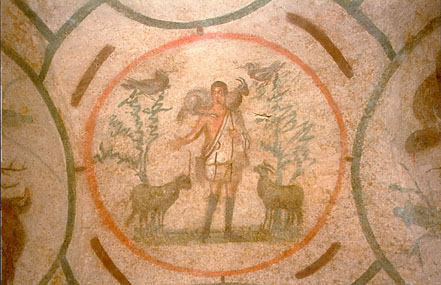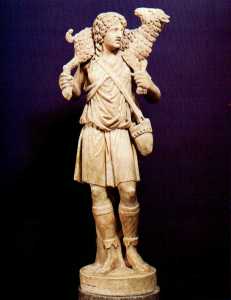This older post remains one of my most popular. Since today’s readings are about God as the Good Shepherd, I thought I’d share it once more.
(Click on images for larger view)
Does your idea of Jesus include the image of the Good Shepherd? Paintings and sculpture of this figure date to ancient times and the Catacombs of Rome contain about 150 such images, showing that this was certainly a popular portrayal of Jesus for early Christians.
I am the good shepherd.
The good shepherd lays down his life for his sheep…
My sheep hear my voice, says the Lord;
I know them, and they follow me.
John 10:14, 27
When Jesus disembarked and saw the vast crowd,
his heart was moved with pity for them,
for they were like sheep without a shepherd;
and he began to teach them many things.
Mark 6:34
The catacombs were extensive networks of subterranean tunnels used to bury the dead from the mid-third through the seventh centuries. Rather like ant colonies, there were about forty separate catacombs, totaling at least 375 miles of tunnels and holding some six and a half million burials. Generally speaking, there were separate catacombs for pagans, Jews, and Christians. Despite popular misconceptions, the catacombs were not used by Christians to hide from Roman persecution. They are mostly dark and dank, and the odor of decaying bodies would certainly have been a deterrent to anyone thinking of lingering there. Most of the bodies were placed in loculi, long slots cut from the tufa stone in stacks one over another. Here’s a photo of what most of the tunnels look like today, though the loculi would likely have been sealed in antiquity after the linen-wrapped corpse was lain inside:
In addition to the tunnels with loculi hewn from the tufa, there are also more elaborate carved and painted chambers or cubicula that held wealthy families, like this one from the Via Latina Catacombs with pagan imagery.
In a cubicula in the Catacombs of Saints Peter and Marcellinus (below), the Good Shepherd is painted in the center of the domed ceiling. He holds a lamb on his shoulders and two sheep lie at his feet, symbolizing the souls that Christ will gather to himself. The lunettes surrounding the Good Shepherd contain episodes from the story of Jonah, whose three days in the belly of the whale were likened to Christ’s resurrection on the third day. The figures with raised hands are in the common orant pose of worship in the ancient world.

Good Shepherd with scenes from Old Testament story of Jonah, early 4th c., Catacomb of Saints Peter and Marcellinus.
If you’re unable to visit Rome to see the catacombs, you can take a Google maps tour of the Catacombs of Priscilla or an online guided tour of the Vatican necropolis.
The Good Shepherd was also a popular image in sculpture for the early Christians, as the example below from the Vatican Museums demonstrates.
From about the fifth century the Good Shepherd image seems to have been replaced by other representations of Jesus as teacher or Pantocrator. One of the last examples of the Good Shepherd is this marvelous mosaic from a royal mausoleum in Ravenna, Italy, with Jesus looking rather more regal than in prior images.
Scholars believe that the Good Shepherd symbol may have been a pagan motif adopted by Christians, as they also adopted signs such as the fish, anchor, and dove. The figure of a youth bearing an animal on his shoulders was known since at least the sixth century B.C. and may have represented a sacrificial offering to Greeks and the idyllic rustic life to Romans. The connection of the shepherd with the Bible was a natural one, though, since the motif was common throughout both Old and New Testaments. Indeed, my Bible concordance lists 137 uses of the word shepherd and its variants. References to God as the shepherd who watches over his people begin in Gen. 48:15, where the elderly Jacob/Israel says that God has been his shepherd all his life. They culminate in Rev. 7:17, when the multitude stands before the throne of God in a land where the Lamb will be their shepherd, leading them to springs of living water where God will wipe away every tear.
Perhaps the most beloved of the Psalms, Psalm 23, best expresses the longing for God as Good Shepherd. I have copied it below as it appears in the lectionary so that, if you choose to, you can repeat the response (in bold) each time as you would in church. Try to place yourself in the setting, with the sound of birds, sheep baah-ing, a peaceful stream babbling, the sun’s warmth upon you, and the security of knowing that, no matter what happens, you are beloved and safe in His care. Truly imagine what it would be like to be in the presence of our Good Shepherd.
R. The Lord is my shepherd; there is nothing I shall want.
The LORD is my shepherd; I shall not want.
In verdant pastures he gives me repose.
Beside restful waters he leads me;
he refreshes my soul.
R. The Lord is my shepherd; there is nothing I shall want.
He guides me in right paths
for his name’s sake.
Even though I walk in the dark valley
I fear no evil; for you are at my side
With your rod and your staff
that give me courage.
R. The Lord is my shepherd; there is nothing I shall want.
You spread the table before me
in the sight of my foes;
You anoint my head with oil;
my cup overflows.
R. The Lord is my shepherd; there is nothing I shall want.
Only goodness and kindness follow me
all the days of my life;
And I shall dwell in the house of the LORD
for years to come.
R. The Lord is my shepherd; there is nothing I shall want.





